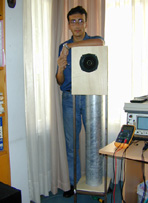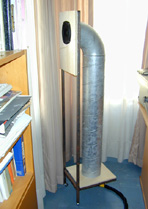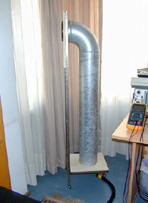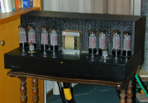
Onur and his speaker |

side view |

and another |

Onur's power amp |
A month ago Onur sent me an e-mail and wanted me to visit his web site where I could see the speakers that he himself designed and built. He also gave me his telephone numbers in case I needed to get more information and perhaps fix an appointment to audition them. Seeing their peculiar look I was curious to hear about them. So I called. He gave me a brief explanation about their working principle, told me that many people adored them and recording studios were buying them. This was enough, I had to go and have a listen.
The speaker looks very simple: it consists of one KEF 160Q coaxial driver, one 161 mm diameter (6.3") galvanized steel pipe, one 3.3uF bipolar capacitor and the supporting structure. But let's try to see a bit further and understand how it works.
The galvanized steel pipe is not as simple as it looks: it's function is rear horn loading in order to boost the bass of the single KEF driver. If we follow its inside from top to bottom we first encounter labyrinth type baffles which are located in the middle of the elbow. These baffles serve to absorb (or stop) all the frequencies above 220Hz, in a way they act like a mechanical crossover. Then, on the beginning of the vertical part, first there is a funnel like throttling followed by a horn shaped cone which ends just before the bottom opening. Onur says that the -3dB point for the low frequencies is 37Hz.
The 3.3uF capacitor serves to cutoff the frequencies below 2.2kHz before sending the signal to the tweeter. This is it.
Enough theory. The power amplifier was Onur's own design (see bottom picture). It's a stereo 100 W push-pull tube amplifier using E34L output tubes (he also has a 50W version). But unfortunately the rest of the system consists of Onur's computer's CD player. The other shortcomings were the room size and the speaker placement. But I must confess that despite all the negatives concerning the ancillaries the speakers sounded very natural and balanced. The bass had weight, extension and presence. Sincerely I was not expecting to hear that much bass. The overall sound was very coherent, seamless and detailed from top to bottom. Congratulations Onur for your innovative and successful design. I look forward to listening to them with my own system to have a better judgment.
Onur has already sold seven pairs, five of them to recording studios. The commercial version has a decent looking cabinet hiding the pipe.
In the future he wants to experiment with
Tannoy and Lowther drivers. I will of course follow-up and report. Well
done Onur!